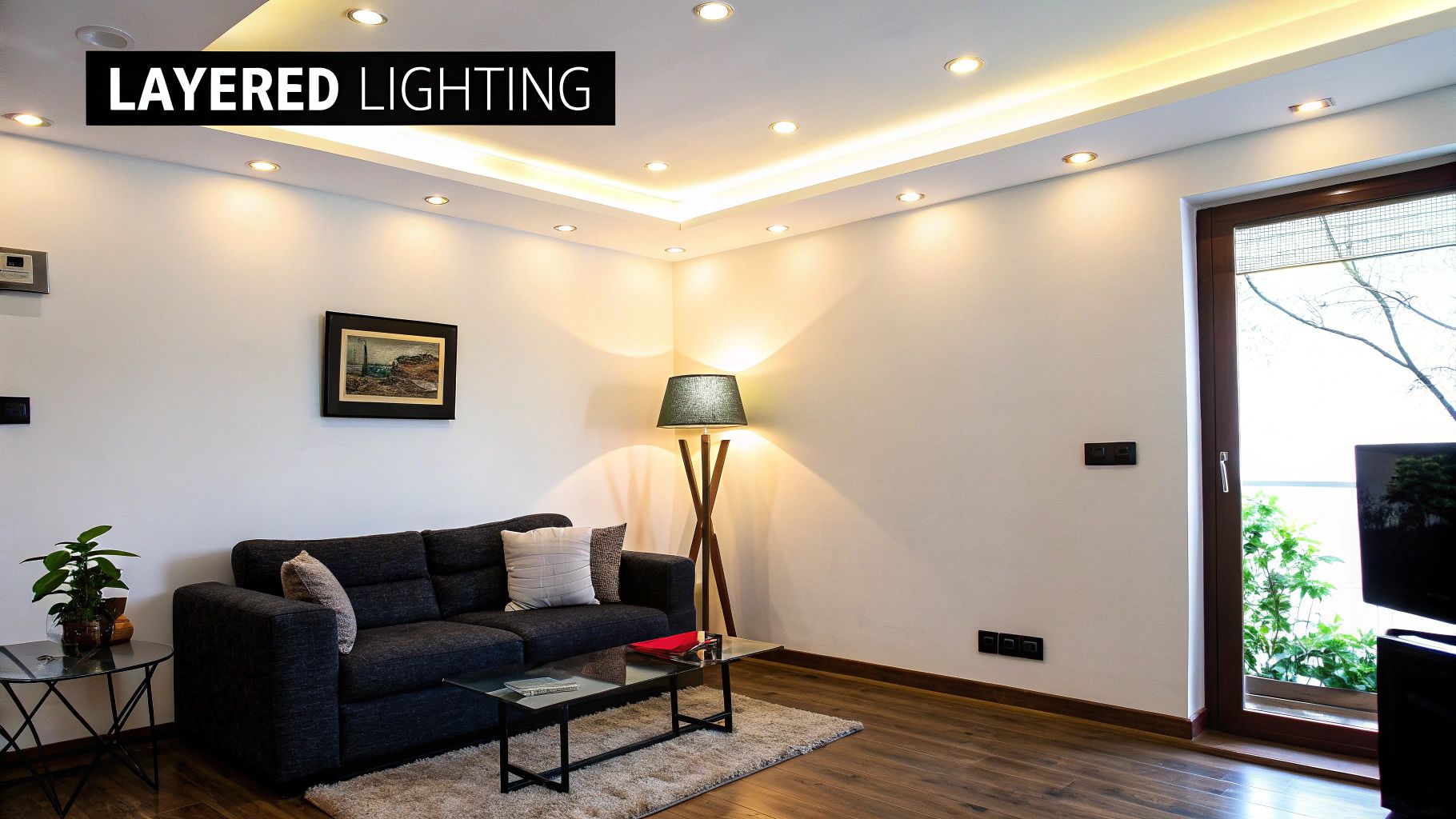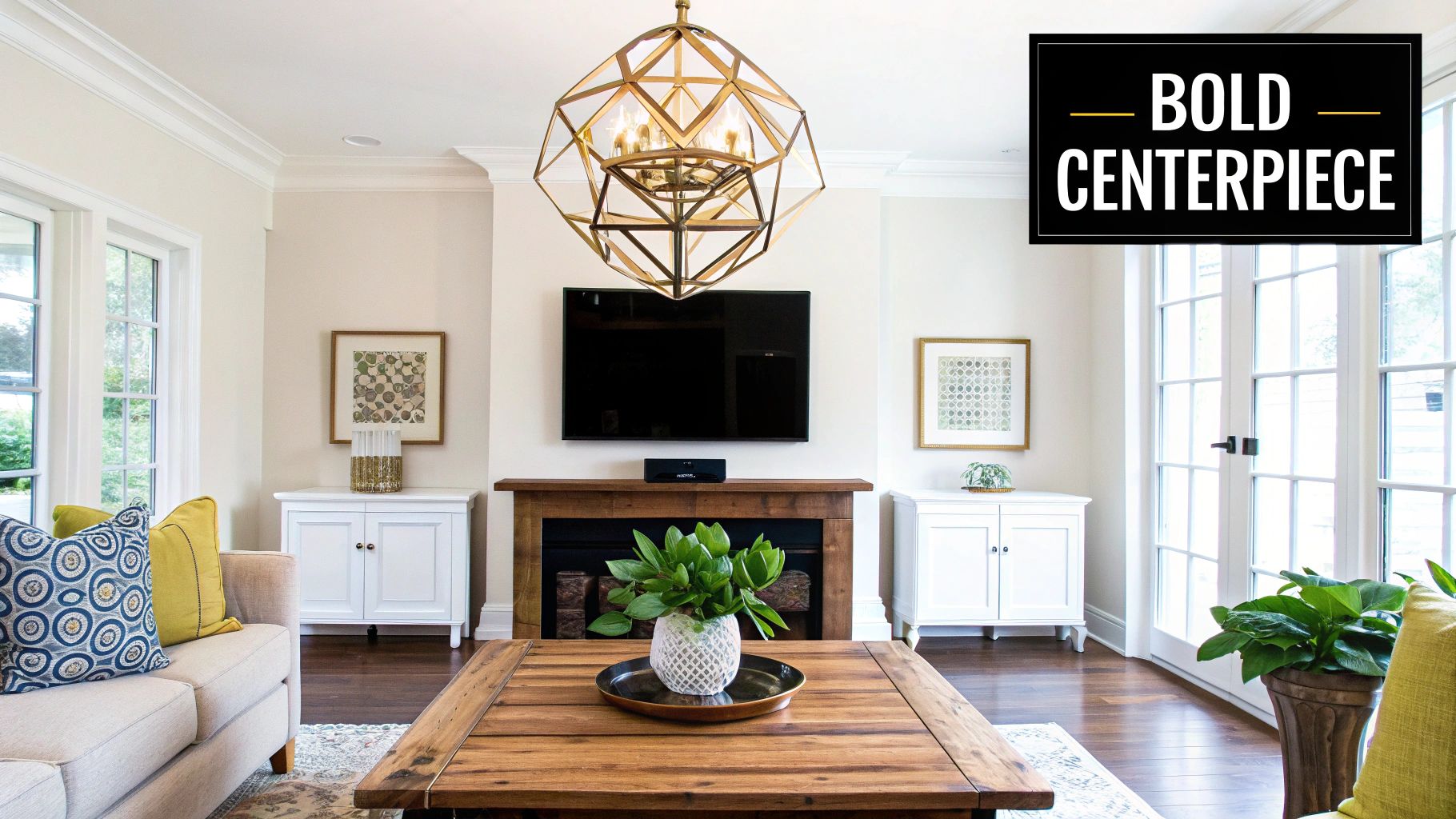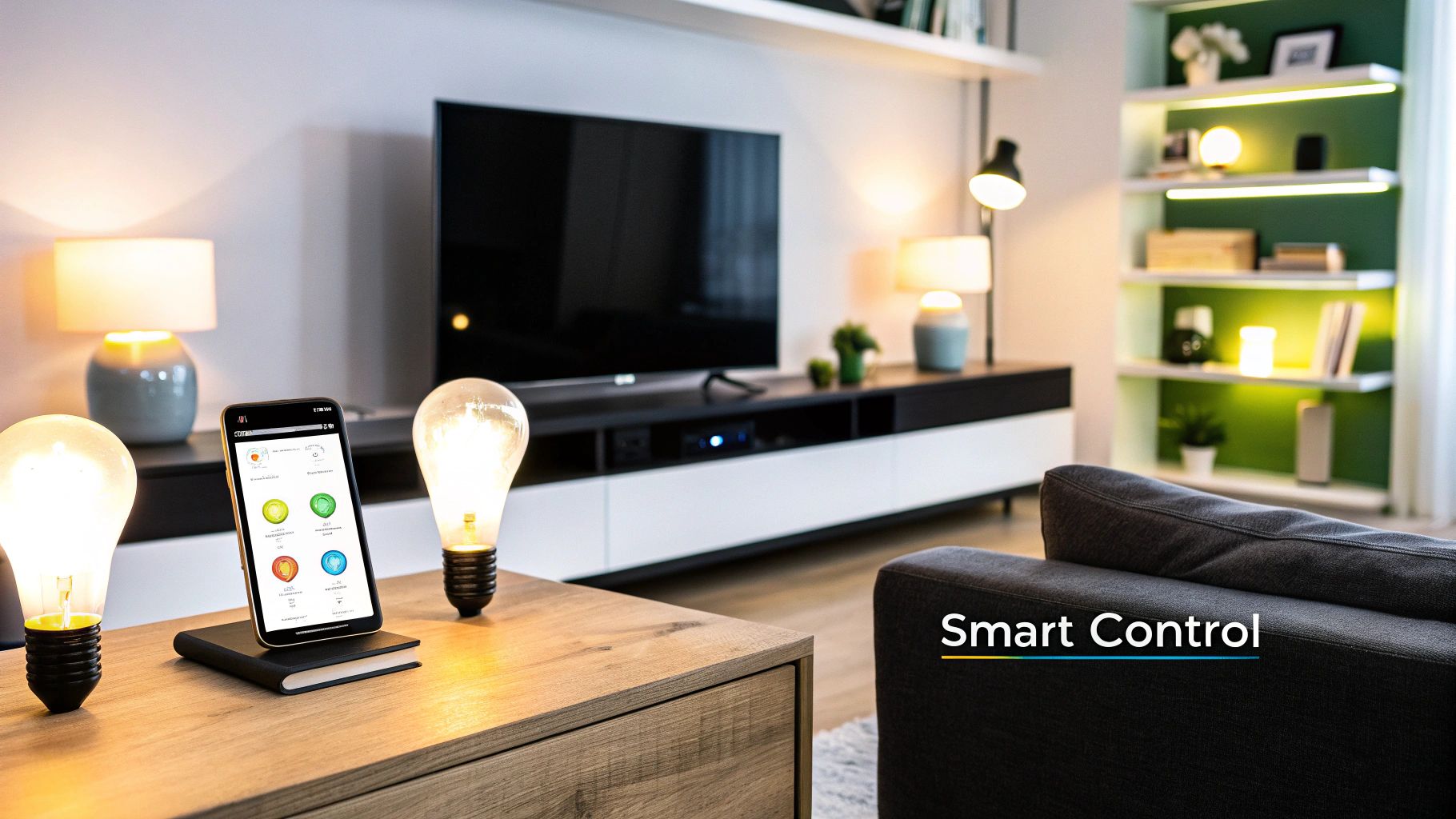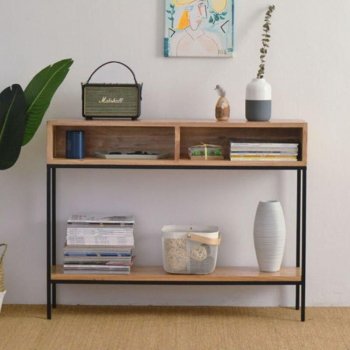9 Best Lighting Ideas for Living Room in 2025

The living room is the heart of the home, a multi-functional space where we relax, entertain, and connect. The right lighting is crucial for setting the perfect mood and ensuring full functionality, but moving beyond a single, harsh overhead fixture can feel daunting. This guide demystifies the process, exploring the best lighting ideas for living room spaces that masterfully combine form and function. We will show you how to implement a layered approach that balances ambient, task, and accent lighting, creating a space that is not only beautifully illuminated but also perfectly tailored to your lifestyle.
A well-lit living room enhances everything from movie nights to quiet reading corners. By strategically placing different types of lights, you can highlight architectural features, create intimate zones, and adapt the atmosphere at a moment's notice. From the sculptural elegance of a statement floor lamp to the seamless integration of smart lighting systems, we will provide actionable tips and real-world examples. Prepare to see your living room in a whole new light as we explore curated selections that can help bring your vision to life, transforming your space into a sophisticated and practical haven.
1. Master the Art of Layered Lighting Design
Layered lighting is the foundational principle behind every professionally designed living room. Instead of relying on a single overhead fixture, this approach strategically combines three distinct types of illumination: ambient, task, and accent. This is one of the best lighting ideas for a living room because it creates a space that is not only functional but also visually dynamic and emotionally resonant.
Ambient lighting serves as the base layer, providing general, even illumination. Task lighting offers focused light for specific activities, like reading or hobbies. Accent lighting, the final touch, adds drama and depth by highlighting artwork, plants, or unique architectural details. By weaving these layers together, you craft a versatile environment that adapts to any mood or occasion.

How to Implement Layered Lighting
To effectively layer light, start with your ambient source and build from there. A central chandelier or a series of recessed lights can establish the room's overall glow. Next, identify activity zones. Place a stylish floor lamp next to an armchair for a reading nook or add a table lamp to a side table.
Finally, introduce accent lighting to draw the eye and create visual interest. Use picture lights over your favorite artwork or aim a small spotlight at a textured wall.
Pro-Tip: The key to a successful layered scheme is control. Install dimmer switches on all your light sources. This allows you to adjust the intensity of each layer independently, creating a custom lighting scene for watching movies, entertaining guests, or relaxing.
By mastering this technique, you can elevate your living room from a simple, flatly-lit space to a sophisticated and inviting sanctuary, a concept that aligns with many of today's latest interior design trends.
2. Make an Impact with a Statement Chandelier
Nothing anchors a living room and establishes a sense of drama quite like a statement chandelier. More than just a light source, these bold, eye-catching fixtures act as the room's primary piece of jewelry, an artistic centerpiece that draws the eye upward and defines the space. This is one of the best lighting ideas for a living room because it instantly injects personality and sophistication, transforming an ordinary room into an extraordinary one.
Modern statement chandeliers are incredibly diverse, moving far beyond traditional crystal designs. You can find options ranging from sculptural, Sputnik-style fixtures popular in mid-century modern decor to industrial black metal geometric shapes perfect for a contemporary loft. By choosing a chandelier that acts as a focal point, you are making a deliberate design choice that elevates the entire room's aesthetic.

How to Select and Hang a Chandelier
Choosing the right chandelier is about balancing scale, style, and function. To find the correct diameter, add the room's length and width in feet, then convert that number to inches. A 12-foot by 15-foot room, for example, would suit a 27-inch diameter chandelier. Ensure the fixture complements your existing style, whether it’s a crystal waterfall design in a formal space or a brass-and-globe fixture in a transitional one.
Hang the chandelier so the bottom is at least 7 feet from the floor in open areas. If placing it over a coffee table, aim for 30 to 36 inches above the tabletop. This positioning ensures it feels integrated with the furniture grouping below without becoming a head-bumping hazard.
Pro-Tip: A dimmer switch is non-negotiable for a living room chandelier. It allows you to transition from bright, functional light for cleaning or finding a lost remote to a soft, ambient glow for movie nights or intimate conversations. Versatility is key.
Popularized by influential designers like Jonathan Adler, the statement chandelier proves that functional elements can also be the most beautiful. It’s a powerful tool for adding a layer of luxury and personal style to your main living area.
3. Recessed LED Lighting
For a clean, modern aesthetic that maximizes ceiling height, recessed LED lighting is an unbeatable choice. These fixtures are installed directly into the ceiling, creating a seamless, unobtrusive look that provides excellent ambient light. This is one of the best lighting ideas for a living room when you want a minimalist feel without sacrificing brightness or functionality. Modern LEDs have evolved far beyond simple can lights; they now offer adjustable color temperatures, full dimming capabilities, and smart home integration.
The beauty of recessed lighting lies in its subtlety and power. It can wash the entire room in a soft, even glow, define different zones in an open-concept space, or serve as a foundational layer that supports more dramatic accent and task lights. This versatility allows it to blend into any design style, from ultra-contemporary to updated traditional, providing a sophisticated and streamlined lighting solution.

How to Implement Recessed LED Lighting
Proper planning is crucial for effective recessed lighting. To achieve even coverage, a general rule is to space fixtures four to six feet apart. In a living room, using warm white LEDs (2700K-3000K) creates a cozy and inviting atmosphere. Consider placing lights on multiple switches or circuits to control different zones independently, such as the main seating area versus a walkway.
For more dynamic layouts, use adjustable "gimbal" style recessed lights. These can be angled to function as accent lighting, highlighting artwork, a fireplace, or architectural features. It’s important to combine recessed fixtures with other types of lighting, like floor or table lamps, to add warmth and prevent the space from feeling sterile or clinical.
Pro-Tip: Upgrade to smart recessed LEDs that integrate with systems like Lutron or Philips Hue. This gives you unparalleled control over brightness and color temperature, allowing you to change your living room's entire mood with a voice command or a tap on your phone.
By strategically installing recessed LEDs, you can create a bright, open, and highly functional living area. Find more information by exploring different types of recessed LED lighting.
4. Floor Lamps as Sculptural Elements
Floor lamps have evolved far beyond their purely functional origins, now serving as powerful sculptural elements that can define a living room's character. Instead of being tucked away in a corner, today’s floor lamps are designed to be seen, functioning as both a source of light and a piece of art. This approach is one of the best lighting ideas for a living room because it adds vertical interest, introduces a distinct style personality, and offers incredible versatility.
From the iconic sweep of an arc lamp over a sofa to the grounded presence of an industrial tripod design, these fixtures command attention. They provide essential ambient or task lighting while simultaneously acting as a focal point. This dual function makes them an efficient and high-impact addition, capable of anchoring a seating area or filling an empty corner with purpose and flair.

How to Implement Sculptural Floor Lamps
To integrate a floor lamp as a design feature, consider its form as much as its function. An arc lamp is a brilliant solution for providing overhead light without the need for ceiling wiring, gracefully extending over a sectional sofa or coffee table. In a Scandinavian-inspired or minimalist space, a tripod floor lamp with a simple linen shade adds texture and a clean, geometric silhouette.
For a more modern or industrial loft setting, a fixture made from metal pipes or with an exposed bulb can introduce a raw, edgy aesthetic. The key is to choose a lamp that not only illuminates the space but also complements and enhances your overall design scheme.
Pro-Tip: Pay close attention to scale and proportion. A tall, slender lamp can make a room with low ceilings feel higher, while a larger, more substantial lamp can hold its own in a spacious room. Ensure the base is properly weighted for stability, especially in homes with children or pets.
5. Install a Dramatic Pendant Lighting Cluster
For a truly show-stopping effect, consider grouping pendant lights together to form a dramatic cluster. This approach moves beyond a single fixture, using multiple pendants hung at varying heights and positions to create a powerful visual centerpiece. This is one of the best lighting ideas for a living room with high ceilings or an open floor plan, as it effectively fills vertical space and draws the eye upward.
A pendant cluster acts as a functional sculpture, providing both ambient and task illumination while adding a significant decorative element. The interplay of different heights, shapes, and materials can create a dynamic, layered look that feels both curated and contemporary. This technique is particularly popular in Scandinavian and industrial design, where a single, bold statement can define the entire room.
How to Implement a Pendant Cluster
When creating a cluster, start by selecting pendants that complement your room's style. You could group three identical glass globe pendants over a seating area or mix different-sized wooden pendants for a Scandinavian aesthetic. Arrange them in a visually pleasing composition, often using an odd number like three or five for a balanced feel.
Vary the hanging heights by 6 to 12 inches to create a cascading effect. Ensure the lowest-hanging pendant is at least 7 feet from the floor to avoid obstructing movement and sightlines. The scale is also crucial; larger pendants suit grander spaces, while smaller ones work well in more intimate settings.
Pro-Tip: For maximum versatility, have each pendant in the cluster wired to a separate switch or group them on a dimmer. This allows you to tailor the light output, from a bright, full-room glow for entertaining to a soft, intimate ambiance with just one or two pendants illuminated.
This method transforms your lighting from a simple utility into a central design feature, showcasing a sophisticated approach to modern living room design, often seen in collections by brands like Muuto.
6. Wall Sconces for Ambient Glow
Wall sconces are an exceptional way to introduce a soft, ambient glow while simultaneously serving as decorative architecture. These wall-mounted fixtures save valuable floor and table space, making them one of the best lighting ideas for a living room of any size. By casting light upwards, downwards, or outwards, sconces wash walls with gentle illumination, reducing harsh shadows and creating an intimate, welcoming atmosphere.
More than just light sources, sconces are design elements that frame features and add character. Whether you choose a modern LED design that grazes a textured wall or traditional fabric-shade sconces for a classic look, they add a layer of sophistication. Their ability to provide both ambient light and accent flair makes them a versatile tool in any lighting scheme.
How to Implement Wall Sconces
For optimal placement, install sconces at approximately 60 to 66 inches from the floor, which is typically just above eye level. This positioning prevents glare while allowing the light to diffuse effectively. Flanking a fireplace, a large piece of art, or a long sofa with a pair of matching sconces creates a sense of balance and symmetry.
Consider the direction of the light. Uplighting sconces draw the eye upward, making the ceiling feel higher and the room more spacious. Downlighting sconces can highlight architectural details below or provide focused light over a console table. For reading nooks, a swing-arm sconce offers adjustable task lighting without cluttering a side table.
Pro-Tip: Always install wall sconces on dimmer switches. This gives you complete control over the room's ambiance, allowing you to dial up the brightness for social gatherings or lower it for a cozy, relaxing evening. Shielded or frosted glass designs are excellent for preventing uncomfortable glare.
Inspired by boutique designers like Schoolhouse Electric, this approach integrates lighting directly into your walls for a polished, custom-designed feel.
7. Embrace Total Control with Smart Lighting Systems
Step into the future of home illumination with smart lighting systems. These are internet-connected fixtures and bulbs that offer unparalleled control and customization, all managed via smartphone apps, voice commands, or automated schedules. This is one of the best lighting ideas for a living room because it allows you to instantly change the entire mood of the space, from a vibrant party atmosphere to a cozy movie night glow, with a simple tap or voice command.
Smart lighting integrates seamlessly into your daily life, offering features like full-spectrum color-changing capabilities, precise dimming, and integration with other smart home devices. Systems like Philips Hue, Lutron Caseta, and LIFX allow you to create a dynamic and responsive environment that adapts to your needs. This technology transforms lighting from a static utility into an interactive element of your home's design and functionality.
How to Implement Smart Lighting
Getting started with smart lighting is easier than ever. Begin by replacing standard bulbs in existing lamps or overhead fixtures with smart bulbs. This provides an immediate upgrade without any complex wiring. For broader control, a smart switch like the Lutron Caseta can manage multiple non-smart fixtures at once, making your entire ambient or accent layer intelligent.
Once installed, use the dedicated app to group lights and create "scenes" for different activities, such as a "Reading" scene with bright, cool light or a "Relax" scene with warm, dim tones. Connect your system to a voice assistant like Amazon Alexa or Google Assistant for hands-free operation.
Pro-Tip: Leverage the scheduling features to enhance your well-being. Program your lights to slowly brighten in the morning, mimicking a natural sunrise, and to gradually dim in the evening, signaling your body it's time to wind down. This automated approach supports a healthy circadian rhythm.
Integrating smart lighting aligns perfectly with creating a fully automated, convenient home environment, much like other modern home technologies. You can learn more about the benefits of home automation here.
8. Embrace the Sophistication of Cove and Indirect Lighting
For a truly high-end, architectural feel, cove and indirect lighting offers a seamless and sophisticated solution. This technique involves placing hidden light sources, typically LED strips, within structural recesses like crown molding, floating shelves, or ceiling trays. The light is cast upward or outward, reflecting off surfaces to create a soft, diffuse glow that illuminates the room without any visible bulbs or harsh glare.
This method is one of the best lighting ideas for a living room when you want to create a luxurious, calming ambiance. It adds a layer of ambient light that makes the space feel larger and more open by highlighting the room's architecture. Instead of a fixture being the focal point, the light itself becomes an integral part of the design, providing a modern, clean aesthetic popularized in luxury hotels and contemporary homes.
How to Implement Cove and Indirect Lighting
Successful implementation requires careful planning. For a ceiling wash effect, install LED strips inside crown molding or a purpose-built cove, ensuring they are positioned to distribute light evenly across the ceiling. You can also integrate this lighting behind a large entertainment center or underneath floating shelves to create a beautiful, weightless effect.
Consider toe-kick lighting under built-in cabinetry or seating for a subtle, guiding light that adds depth at a lower level. Planning the electrical routing during a renovation or construction phase is ideal, but retrofit options are also available.
Pro-Tip: Always opt for dimmable, warm white LEDs (around 2700K-3000K) to achieve a cozy, residential feel rather than a sterile, commercial one. Using a diffuser channel over the LED strips will also help eliminate any "hot spots" or visible dots, ensuring a smooth, continuous line of light.
9. Table Lamps for Intimate Lighting
Table lamps are the unsung heroes of living room lighting, offering a blend of function, flexibility, and decorative flair. These portable fixtures, placed on side tables, consoles, or desks, provide warm, personal-scale illumination that is essential for creating cozy nooks and intimate conversation areas. This is one of the best lighting ideas for a living room because table lamps serve as crucial task lights while also acting as stylish accent pieces that complete your decor.
They are incredibly versatile, allowing you to easily add light exactly where it's needed without the commitment of hardwired fixtures. Whether you’re flanking a sofa with a matching pair for a sense of symmetry or placing a single statement lamp on a console table, they bring both light and personality to any surface. Their ability to soften a room with a gentle glow makes them indispensable for a welcoming atmosphere.
How to Implement Table Lamps
Start by identifying surfaces that could benefit from both light and a decorative touch. A modern geometric lamp next to a reading chair or a pair of classic ceramic lamps on the end tables beside your sofa can anchor the seating area. For a more dynamic, less formal look, try placing lamps asymmetrically throughout the room.
Ensure the lamp is proportional to the table it sits on, a common guideline is that the lampshade should be no wider than the table itself. Brands like Room & Board offer a wide selection of contemporary designs to suit any style.
Pro-Tip: Pay close attention to the shade. The bottom of the lampshade should be at eye level when you are seated to avoid glare. For a warm, inviting glow perfect for a living room, choose bulbs with a color temperature between 2700K and 3000K.
Top 9 Living Room Lighting Ideas Comparison
| Lighting Type | 🔄 Implementation Complexity | ⚡ Resource Requirements | 📊 Expected Outcomes | 💡 Ideal Use Cases | ⭐ Key Advantages |
|---|---|---|---|---|---|
| Layered Lighting Design | Moderate to High Needs planning & multiple fixtures |
Multiple fixtures, switches, dimmers | Even, flexible lighting with depth and mood | Whole-room versatile lighting | Optimal activity lighting, mood control |
| Statement Chandeliers | Moderate Professional installation often needed |
High-quality single fixture, adequate ceiling height | Dramatic focal point and ambient lighting | Large rooms, high ceilings, statement piece | Instant elegance and sophistication |
| Recessed LED Lighting | Moderate Ceiling modification required |
LED fixtures, electrical work | Clean, shadow-free ambient light | Minimalist, contemporary spaces | Energy efficient, unobtrusive design |
| Floor Lamps as Sculptural Elements | Low Plug-and-play, flexible placement |
Single fixture, floor space | Ambient/task light with artistic flair | Flexible, movable lighting accents | Portable, artistic, affordable |
| Pendant Lighting Clusters | Moderate Careful spatial arrangement |
Multiple fixtures, ceiling height | Focused zones with visual drama | High ceilings, open plans | Intimate zones, architectural interest |
| Wall Sconces for Ambient Glow | Moderate Wall installation and wiring |
Fixed fixtures, electrical work | Soft, diffused ambient light, saves floor space | Small spaces, ambient/cozy lighting | Space-saving, architectural enhancement |
| Smart Lighting Systems | High Setup, programming, Wi-Fi required |
Smart bulbs, hubs, stable internet | Customizable, automated, energy-efficient | Tech-integrated homes, convenience seekers | Remote control, automation, security |
| Cove and Indirect Lighting | High Professional install and planning |
Hidden fixtures, LED strips | Soft, glare-free ambient, architectural highlight | Luxury, spacious, sophisticated ambiance | Glare-free, spacious feel, luxury aesthetics |
| Table Lamps for Intimate Lighting | Low Simple placement, plug-in |
Single fixture, surface space | Warm, personal-scale light | Cozy corners, task lighting, decor accents | Portable, warm atmosphere, affordable |
Bringing Your Luminous Vision to Life
As we've explored, crafting the perfect atmosphere in your home goes far beyond simply choosing a single fixture. The journey to find the best lighting ideas for your living room is an exercise in creativity, strategy, and personal expression. It’s about understanding that light itself is a design material, one that can be shaped and molded to build the exact ambiance you desire for every moment, from a lively gathering to a quiet evening with a book.
Synthesizing Your Lighting Strategy
The most crucial takeaway from our deep dive is the principle of layered lighting. This isn't just an industry buzzword; it's the foundational framework for a dynamic and adaptable living space. By weaving together different sources of light, you gain complete control over the mood and functionality of your room.
Let's recap the core layers we discussed:
- Ambient Foundation: Start with your general, room-filling light. This could be the soft, even illumination from recessed LEDs, the gentle glow from cove lighting, or the widespread radiance of a central chandelier.
- Targeted Task Lighting: Next, introduce focused light for specific activities. A sculptural floor lamp beside your favorite armchair for reading, or a stylish table lamp on a console for sorting mail, ensures every corner is as practical as it is beautiful.
- Dramatic Accent Lighting: This is where you inject personality. Use wall sconces to highlight architectural details, or aim a spotlight at a piece of art. Accent lighting draws the eye and creates visual interest and depth.
From Ideas to Implementation
Moving from concept to reality is the most exciting step. Don't view these ideas as a rigid checklist, but rather as a palette of options. The true magic happens when you mix and match. A modern smart lighting system can coexist beautifully with a vintage-inspired statement chandelier. Sleek, minimalist recessed lights can provide the perfect functional contrast to an ornate, decorative table lamp.
Key Insight: Your final lighting scheme should be a reflection of your lifestyle. The goal is not to install every type of light, but to select the right combination that serves your unique needs and aesthetic preferences.
Embracing this layered approach transforms your living room from a static environment into a responsive one. With the right combination of dimmers and smart controls, you can shift the entire feel of the space with a simple tap or voice command. This is the ultimate value of a well-executed lighting plan: it empowers you to be the architect of your own atmosphere. Your living room becomes more than just a room; it becomes a canvas for light.
Ready to turn these ideas into your beautifully lit reality? Explore the curated collections on escalone.com to discover unique and high-quality fixtures that match your vision. From statement-making chandeliers to versatile smart lamps, escalone.com offers an extensive marketplace to find the perfect pieces to complete your living room's lighting design.


















Leave a comment